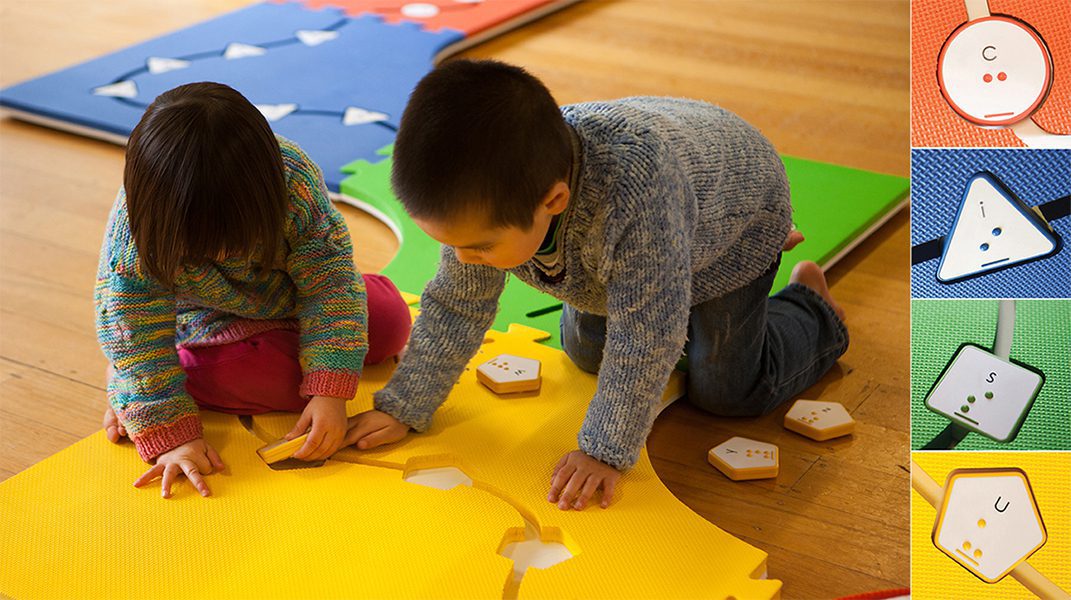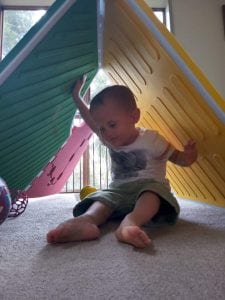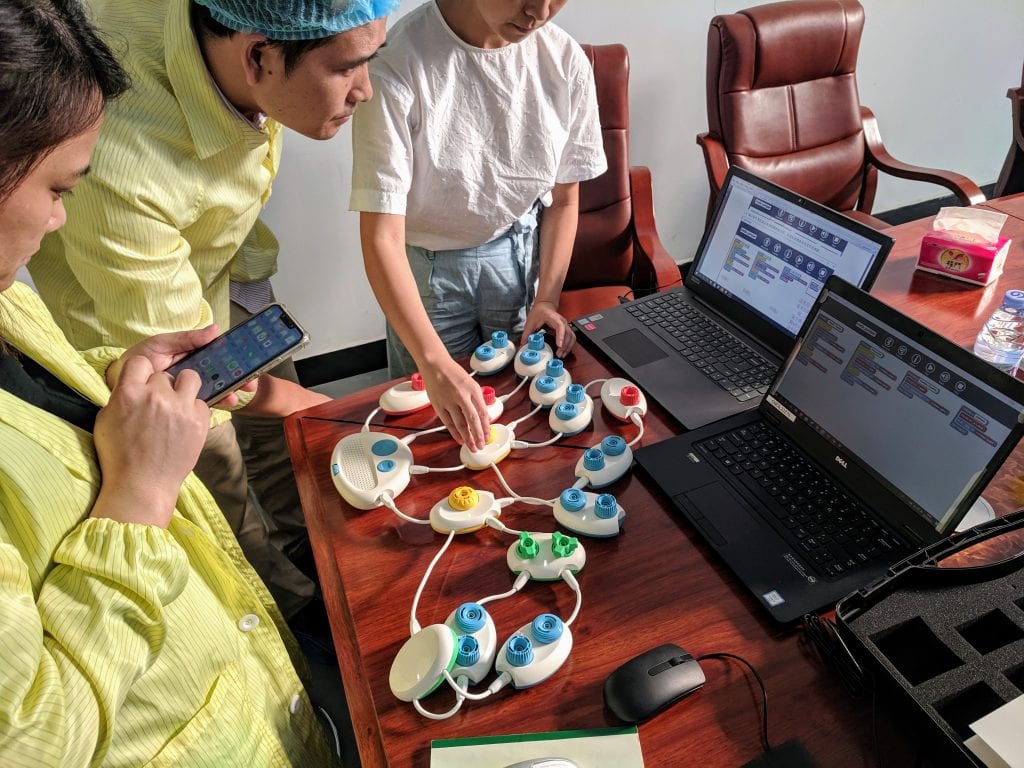Please be advised USPS is experiencing unusually long delays for Free Matter For The Blind shipping. If you have not received an order placed more than 30 days prior, please contact the APH Customer Service team at support@aph.org or 1-800-223-1839.
ClosePlay-Based Reach & Match Supports School Readiness, Core Curriculum, and ECC

Barbara Peterson, APH Scholar and vision consultant for the Montana School for the Deaf and Blind, believes the Reach & Match kit is a great way to teach many levels of learning to students of all ages. “It’s an awesome tool that can promote team collaboration between those working with students and children with special needs. It also can be used to ‘bridge the gap between the separate skill sets that each player brings to the team.’ Teachers, students with visual impairments, physical therapists, occupational therapists, and O&M specialists can use their own creativity to meet the specific goals that they set for their students.”
Barbara shared her application of Reach & Match with us at the Access Academy webinar Creative Learning to Meeting Educational and Therapy Goals Using the Reach & Match on March 30, 2021.
She offered some very valuable advice on Reach & Match application that she learned when she collaborated with related services on the educational team. Her presentation was divided into four segments, and each addressed a different area:
- Early Learning – A physical therapist worked with a family to use Reach & Match for their infant toddler at home.
- Orientation & Mobility – An O&M specialist worked with a preschool student to use his cane with Reach & Match at school.
- Physical Therapy – A physical therapist used the Reach & Match to teach postural control and locomotor skills with older students at school.
- Occupational Therapy – An occupational therapist utilized Reach & Match to teach tactile exploration and attention and memory skills with older students at school.

I was thrilled and inspired to learn about Barbara and her team’s creative application of Reach & Match for children of different ages and learning needs. Her sharing provided very useful insights for users to understand the flexibility and innovation of the Reach & Match.
Bridge Core and Expanded Core Curriculum with Reach & Match
The Reach & Match Inclusive Learning Program is underpinned by seven Learning Outcomes, including Braille & Print Literacy, Cognitive Skills, Sensory Integration, Body Concept, Orientation & Mobility, Language Enrichment, and Social Interaction. The design of these Learning Outcomes aligns with the Core and Expanded Core Curriculum including Literacy, Mathematics, Orientation & Mobility, Sensory Efficiency, and Social Skills. Below are examples of Reach & Match activities that can support children in developing these CC and ECC areas:
- Literacy
- Pre-braille activities through exploring the Reach & Match components including different materials, textures, shapes and sizes, and so forth.
- 26 braille and print alphabet tiles assist the development of letter recognition and fine motor skills and basic spelling.
We believe that learning involves children’s whole body. Movement would be helpful to strengthen their learning and memory. Jenny Griffiths, an inclusive education advisor from our partner organization Callan Service in Papua New Guinea, shared how Reach & Match supports her students with disabilities to learn the alphabet:
“The feedback from the pilot case was amazing because it is play-based; it is pre-numeracy and pre-literacy training. One of the teachers from Arawa has been working with children in the 4-8 age group for a couple of years trying to teach them the alphabet, and they have been staring at her blankly, but through using this play-based approach, they have learned the alphabet within 3 weeks. They have loved it. It uses games, exercises, and is fun whilst being age-appropriate.”
- Mathematics
- Sorting, matching, and counting are basic forms of algebra in Mathematics, e.g., children learn to sort the shapes and identify the patterns with the Reach & Match tiles.
- Sequencing and memory training: Sequence is a basic math skill that creates and identifies a pattern, e.g., the teacher can create a sequence in shapes (or sounds) and ask the student to create the same patterns.
- Orientation and Mobility
- Finger manipulation: Pick up a specific tile, track the path using the finger.
- Wrist twisting: Fit different shapes into its pockets, shake the tile.
- Gross motor skills: Learn about crawling, walking, jumping, leaping.
- Orientation concepts and language development – e.g., wall, floor, roof, in, out, left, right, up, down, under, over, etc.

- Sensory Efficiency
- Sensory Integration: Reach & Match provides activities that specifically support sight and visual skills, hearing integration and touch integration, body movement.
- Visual tracking, visual discrimination, tactual readiness.
- Social Skills
- All 16 Reach & Match games allow group play that supports social interaction, active listening, active participation, turn-taking, cooperation skills, and teamwork.
We’ve received more encouraging feedback from Jason Ross, project officer for Save the Children in the Solomon Islands. He said, “The design provided so many opportunities for all children to be engaged in games and activities. Children who have a visual impairment participated fully in alphabet games alongside sighted children due to each tile having the braille component. Another young child who could not walk was the group leader. He confidently placed shapes into their correct place as his teammates ran towards him as part of the shuttle relay race. The children have had an incredible time and will no doubt benefit enormously from the Reach & Match toolkit going forward.”
Reach & Match New Development
We are very excited to share with you that we have developed a series of program training videos that include about 40 activity animations and over 20 lesson plans, including game instructions, additional ideas, teachers’ strategies, and evidence of learnings. These videos were created to help teachers understand and apply the activities immediately. Additionally, we also provide live training webinars tailored for groups.
To learn more, watch APH’s Access Academy webinar on Creative Learning to Meeting Educational and Therapy Goals Using the Reach & Match or visit the Reach & Match website.
Share this article.
Related articles

Cross the River into Fun with Reach & Match
Are you a teacher looking for activities your students with and without visual impairments can do together? If you want...

More Than Computer Coding: Learning Together
“It’s like a game, but there are pods, and you can make stories and music.” That’s how 10-year-old Angel Cantu-Rincon...

Behind The Scenes: The Making of Code Jumper
Andrew Moulton is used to experiencing a lot of “firsts.” As the Director of Technical and Manufacturing Research, he spends...
